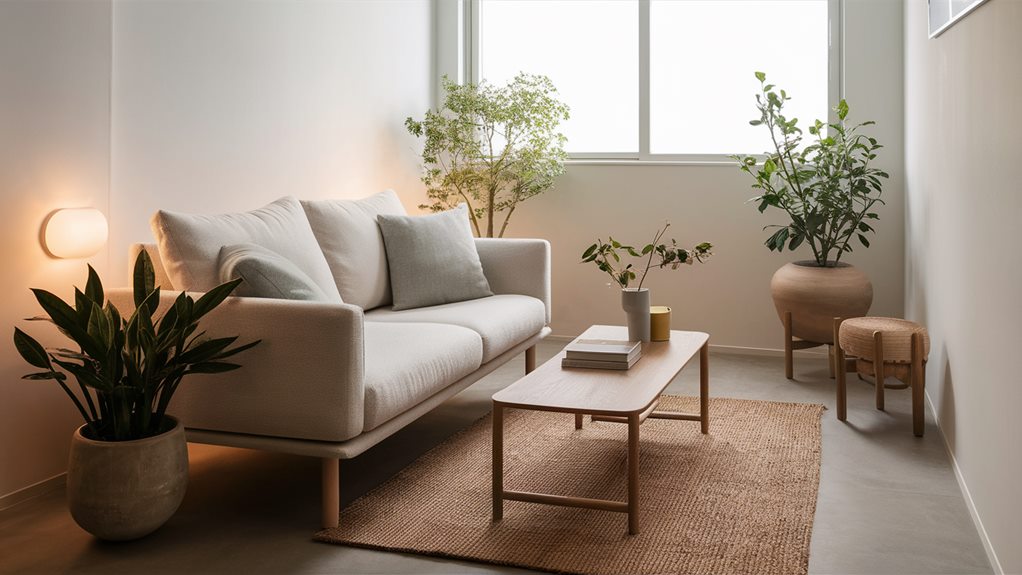To create a minimalist space, embrace neutral color palettes that amplify light and airiness. Choose multi-functional furniture like sofa beds and nesting tables to save space while enhancing functionality. Optimize vertical space with wall-mounted storage, and opt for clear shelving to maintain an open feel. Limit decorative accessories to standout pieces that reflect your style, and select simple textures to invite warmth. Finally, define zones with strategic furniture arrangements and varied lighting. By following these tips, you'll not only enhance your small space but also create a serene retreat that feels uniquely yours. There's much more to discover!
Key Takeaways
- Embrace neutral color palettes to create an open, airy atmosphere and promote calmness in small spaces.
- Choose multi-functional furniture to optimize space and enhance practicality, such as sofa beds and nesting tables.
- Optimize vertical space with wall-mounted storage and tall shelves, freeing up floor space and creating a sense of spaciousness.
- Limit decorative accessories to standout pieces that reflect personal style and maintain a serene environment.
- Create defined zones using furniture arrangement and area rugs to enhance functionality and promote a sense of belonging.
Embrace Neutral Color Palettes

When it comes to small spaces, a neutral color palette can be your best friend. By using soft shades like whites, beiges, and greys, you create an open, airy atmosphere that instantly feels more inviting. This approach aligns beautifully with color psychology, as neutral tones promote calmness and balance, making your space feel like a true sanctuary.
To enhance comfort and style, consider incorporating a stylish area rug that complements your neutral base, adding texture and warmth to the room.
To add depth and personality, consider incorporating accent hues. Whether it's a vibrant throw pillow, an art piece, or a bold rug, these pops of color can energize your space without overwhelming it. The key is to select accents that resonate with you, enhancing your sense of belonging.
You'll also find that a neutral palette offers versatility. It allows you to change your decor with ease, so you can adapt your space to reflect your mood or style over time. By embracing a neutral foundation, you set the stage for creativity while maintaining a cohesive look.
Ultimately, a neutral color palette not only maximizes your small space but also fosters a comforting environment where you can truly feel at home.
Choose Multi-Functional Furniture

Maximizing space in a small room often hinges on your choice of furniture. Opting for multi-functional pieces can transform your living area into a haven of style and practicality.
Look for space-saving solutions that effortlessly blend into your decor while serving multiple purposes. For instance, consider a sofa bed for your living room; it not only provides seating but also a cozy spot for guests to rest.
Nesting tables can serve as side tables during the day and combine into one for a neat, streamlined look at night. Versatile designs, like ottomans with hidden storage, can help you declutter while adding extra seating when needed.
When shopping, think about how each piece can adapt to your lifestyle. A dining table that expands or collapses can accommodate both intimate dinners and larger gatherings.
Optimize Vertical Space
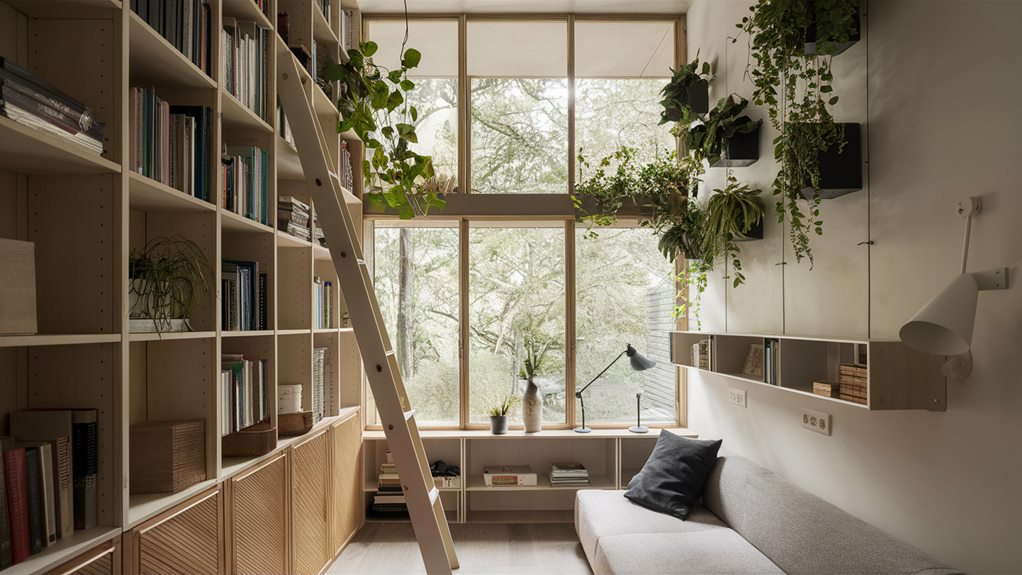
After selecting multi-functional furniture, the next step is to make the most of your vertical space. Embracing height is key to creating a functional and aesthetically pleasing environment in small spaces.
Think about incorporating top desk cable organizers to keep your workspace tidy and free from clutter. Here are three ideas to reflect on:
- Wall Mounted Storage: Maximize your walls with shelves or cabinets that free up floor space. Use them to store essentials or display decorative items that bring you joy.
- Vertical Gardens: Bring life into your space with hanging planters or vertical gardens. They not only purify the air but also infuse your home with a fresh, organic aesthetic.
- Ladder Shelves and Tall Bookcases: Invest in ladder shelves or tall bookcases. These pieces draw the eye upward, making your space feel larger while providing ample storage for books and personal treasures.
Additionally, think about using ceiling hooks for hanging items like bikes or plants, and stackable bins for organizing smaller items.
Don't forget to utilize vertical artwork to add character without taking up precious floor space. By optimizing vertical space, you can create a serene, organized home that feels inviting and personal.
Limit Decorative Accessories
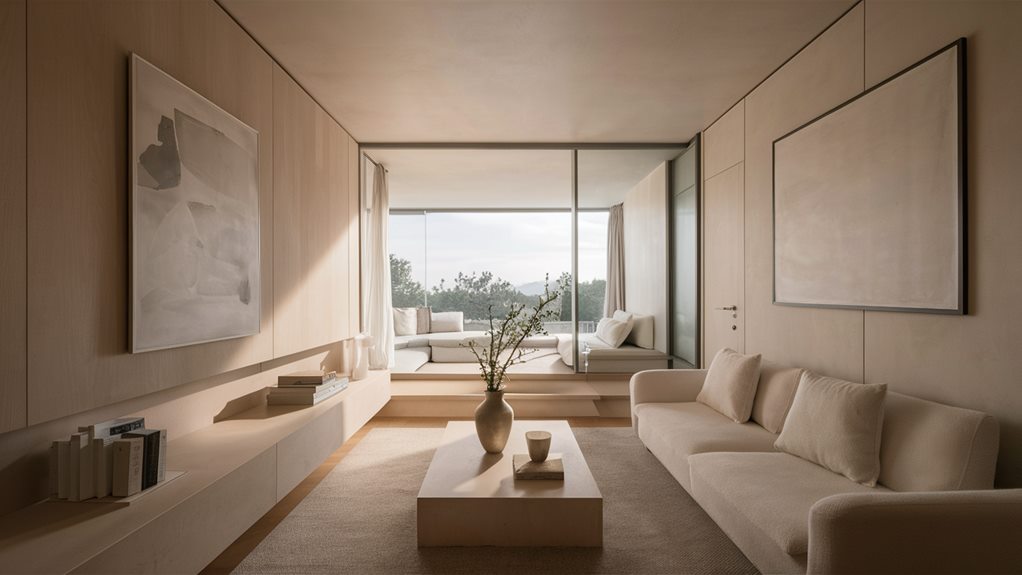
How can you create a visually appealing space without overwhelming it? The answer lies in limiting your decorative accessories. Embrace the concept of decorative balance by choosing a few standout pieces that resonate with your personal style. Instead of cluttering surfaces with multiple items, opt for a single, striking accessory that draws attention and adds character.
Think about accessory functionality as well. Each item should serve a purpose or evoke a feeling that enhances your space. A well-placed plant can bring life to a room, while a carefully chosen piece of art can become a conversation starter.
By curating your accessories, you not only create a more serene environment but also foster a sense of belonging. When each piece has significance, it reflects your personality and story.
Remember, simplicity is key. Select items that harmonize with the overall aesthetic and contribute to the room's functionality.
Dare to let go of excess, and you'll find that less truly is more. With intentional choices, you'll achieve a beautiful, minimalist space that feels inviting and uniquely yours.
Incorporate Natural Light
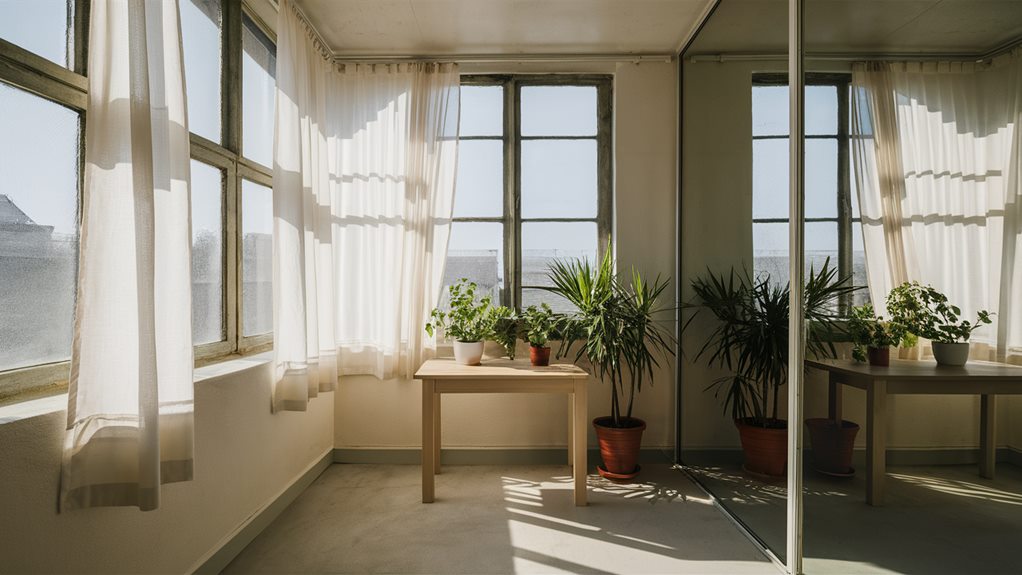
To enhance your minimalist space, embrace the beauty of natural light. It creates an inviting atmosphere and highlights the simplicity of your design. Here are three effective ways to incorporate natural light into your home:
- Choose the Right Window Treatments: Opt for sheer fabrics that allow light to filter through while maintaining privacy. This not only brightens your space but also softens harsh sunlight.
- Utilize Mirrors Strategically: Mirror placement can amplify light reflections, making your small area feel larger. Position mirrors across from windows to bounce light around the room and enhance the overall brightness.
- Incorporate Indoor Plants: Select indoor plants that thrive in natural light. They add a touch of greenery while purifying the air. Choose natural materials for pots to maintain a cohesive, minimalist look.
Incorporating light layering with varying color temperatures can also enhance the ambiance, especially in open layouts.
Select Simple Textures
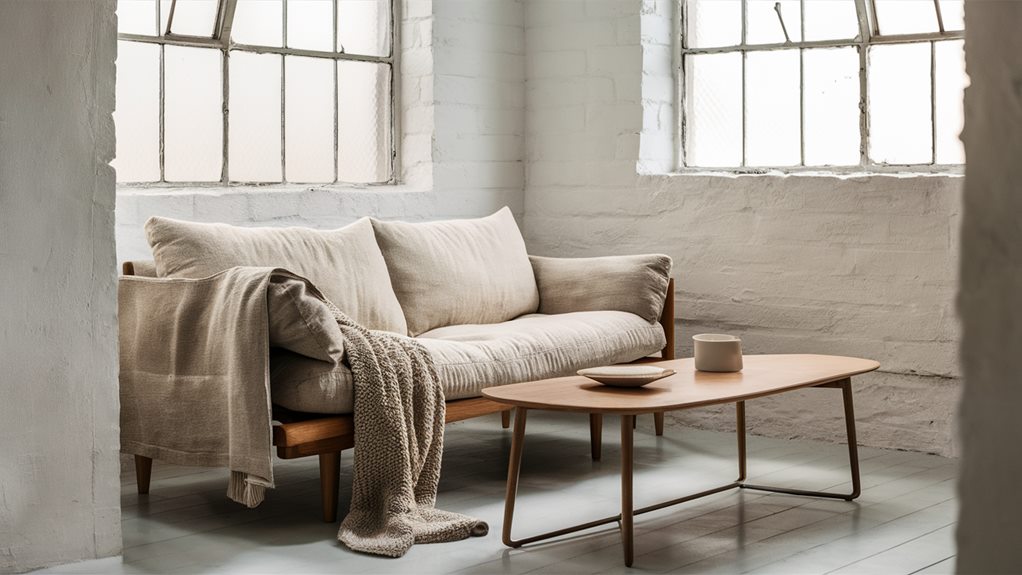
In a minimalist space, selecting simple textures can elevate the overall aesthetic without overwhelming the senses. Embrace the beauty of layered textiles to create comfort and warmth. Think of a soft linen throw draped over a sleek sofa or a chunky knit blanket paired with cotton cushions.
These combinations not only add visual interest but also invite touch, enhancing the feeling of belonging in your home.
Tactile contrasts are key in achieving a cohesive yet dynamic look. Mix smooth surfaces, like a polished wood table, with more textured elements, such as a woven rug or a jute basket.
This interplay creates depth and encourages exploration of your space, drawing the eye and inviting guests to engage.
Keep your color palette neutral to maintain a serene atmosphere while allowing textures to shine. Subtle patterns can add character without cluttering the visual field.
Use Clear or Open Shelving
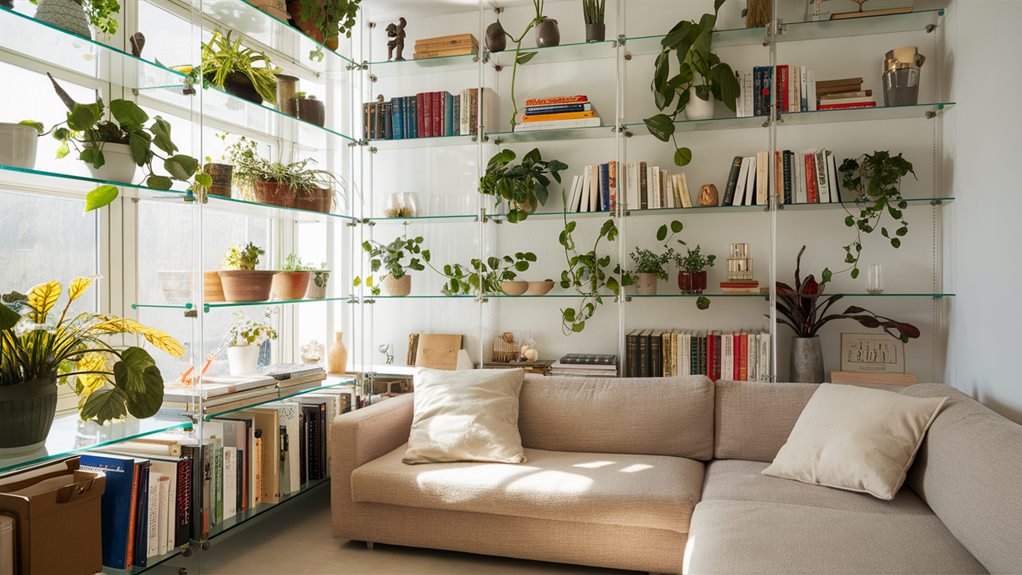
While embracing minimalist design, using clear or open shelving can greatly enhance the perception of space in your home.
These shelving solutions not only create an airy feel but also allow for creative display arrangements that reflect your personality. By using transparent or open shelving materials, you can showcase your favorite items while keeping the environment uncluttered.
Here are three tips to make the most of your open shelving:
- Choose cohesive shelving materials: Opt for glass or light wood. These materials blend seamlessly with your decor and maintain a clean aesthetic.
- Curate your display arrangement: Limit the number of items on display. Focus on a few meaningful pieces that evoke a sense of belonging—this could be art, books, or cherished mementos.
- Layer and group thoughtfully: Use a mix of heights and shapes to create visual interest, while ensuring that the overall look remains balanced and uncluttered.
Prioritize Quality Over Quantity
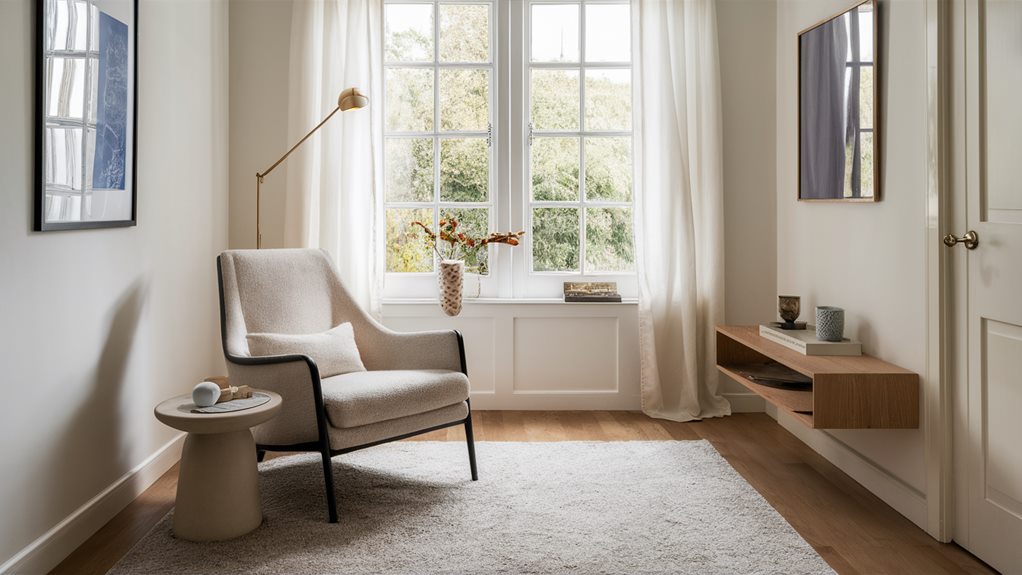
Open shelving invites a chance to curate your space, but the key to truly embracing minimalist design lies in prioritizing quality over quantity. When you're working with limited space, each item should serve a purpose and reflect your style. This is where intentional purchases become essential.
Instead of filling your shelves with numerous trinkets, focus on investment pieces that stand out and add character. Choose items crafted from durable materials, like solid wood or high-quality ceramics, ensuring they'll last and age beautifully.
These select pieces not only enhance your decor but also create a sense of belonging, as they tell a story about who you are. Remember, it's about creating a serene environment that resonates with you.
By embracing quality, you'll cultivate a space that feels curated rather than cluttered. Each item should evoke joy and serve a function, whether it's a chic vase or a beautifully designed book.
Ultimately, by prioritizing quality over quantity, you transform your small space into a harmonious retreat that reflects your values and personality. Less truly can be more when each piece is chosen with intention and care.
Create Defined Zones
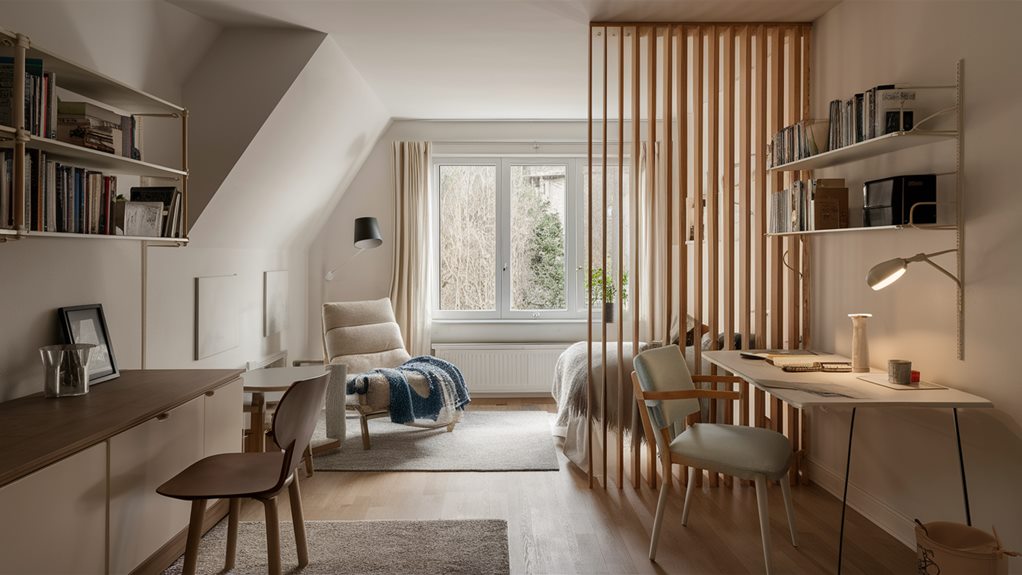
Creating defined zones in a small space can greatly enhance its functionality and flow. By establishing clear areas for specific activities, you'll create a sense of belonging and organization.
Here are three effective ways to achieve zone division:
- Furniture Arrangement: Position your furniture to delineate different areas. For instance, use a sofa to separate the living area from the dining space. This creates a natural boundary while maintaining spatial flow.
- Rugs: Use area rugs to define zones. A rug under the dining table or in a reading nook can visually signal a distinct area, enhancing both comfort and style.
- Lighting: Vary your lighting to suit each zone. A pendant light over the dining table, paired with a floor lamp in the reading area, reinforces the purpose of each space while adding ambiance.
Frequently Asked Questions
How Can I Make a Small Space Feel Larger With Mirrors?
You can make a small space feel larger by using mirrors strategically.
Start with mirror placement across from windows to maximize natural light, enhancing the reflective surfaces in your room.
Consider adding a large mirror to create depth, or smaller mirrors in a gallery wall for added interest.
What Are Some Affordable Minimalist Design Resources or Inspiration Sources?
When you're seeking affordable minimalist design resources, start by exploring online design inspiration platforms like Pinterest and Instagram. They offer countless ideas for budget-friendly decor that suit your style.
Look for blogs and websites dedicated to minimalism; they often feature DIY projects and thrift finds that can elevate your space without breaking the bank.
How Do I Maintain a Minimalist Space With Pets or Children?
Maintaining a minimalist haven with pets or kids can be a balancing act.
Prioritize pet-friendly furnishings that withstand wear and tear while keeping your space sleek.
Opt for child-proof decor that blends beauty with safety, ensuring your environment stays aesthetically pleasing.
Embrace smart storage solutions to hide toys and pet essentials, allowing for a clutter-free look.
With thoughtful choices, you'll create a serene space that welcomes both playfulness and peace.
Can I Mix Different Styles in a Minimalist Design?
Absolutely, you can mix different styles in a minimalist design!
Just focus on achieving style harmony and color balance. Choose a few key pieces from various styles that complement each other, maintaining a cohesive look.
Opt for a neutral palette to unify the space, while adding pops of color through accessories.
This approach not only enhances aesthetics but also creates a functional environment where you feel a sense of belonging and comfort.
How Do I Choose the Right Plants for a Minimalist Space?
You might think adding plants clutter your minimalist space, but the right selections enhance your aesthetic.
Choose low maintenance options like snake plants or pothos; they're not only easy to care for but also bring life to your environment.
Look for simple pots that complement your design.
Conclusion
In the garden of your small space, each design choice is a seed planted for growth. By embracing neutral colors like soft soil, and choosing multi-functional furniture as sturdy vines, you cultivate harmony. Let natural light be the sun that nurtures your corner oasis, while clear shelving acts as transparent trellises supporting your style. Prioritize quality blooms over a cluttered harvest, and soon you'll find defined zones flourishing, transforming your space into a serene sanctuary where simplicity thrives.

